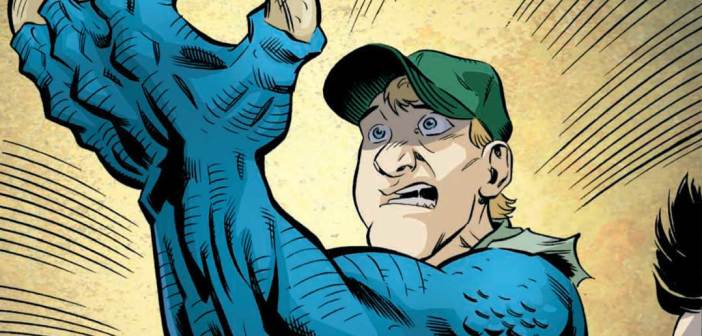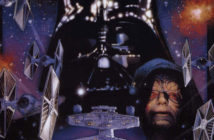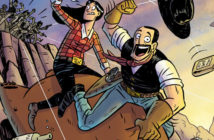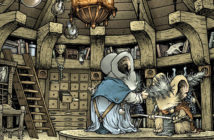One of the freshest titles being published by Red 5 Comics today is We Kill Monsters, the brainchild of Chris Leone and Laura Harkcom. Both living in Los Angeles, CA, Leone and Harkcom bring years of entertainment experience to their original comic book title, most notably their dual endeavor of writing and executive producing the original Emmy-nominated Sci-Fi Channel miniseries, The Lost Room. They first met during college while attending Carnegie Mellon University, marking the beginning of their professional relationship.
I recently had the opportunity to chat with Leone and Harkcom about their careers, creativity, and comic books.
Steven Surman: To begin, let’s first touch upon your lives as writers: When did you both first start writing down your creative ideas?
Laura Harkcom: I started writing plays when I was a kid. I would force my sister to play the thankless parts. Apparently, if anyone in the “audience” (i.e., my family) talked during one of my performances, I would stop and start all over again.
Chris Leone: I’ve been writing stories and making short films since I was a little kid. I started taking it a bit more seriously at the end of high school.
SS: How old were you when you decided you wanted to worker as writer, or at least in the entertainment industry?
LH: As soon as I could read the credits on movies and television shows and my mom explained to me that someone actually wrote those movies and shows, I knew that’s what I wanted to do. I think I was around five.
CL: Actually, I have a much longer career in visual effects and animation than in writing. To this day, the idea of being a career screenwriter leaves me kind of cold. You can have a very successful screenwriting career in Hollywood and never get a movie made. I’m much more excited about making things—comics, films, animation—than I am about strictly writing. I started directing commercials this year, which is surprisingly rewarding in this respect.
SS: What were your first big breaks?
LH: As a writer, I’d say it was selling our first pitch to Columbia Pictures. They then hired us to write a script based on that pitch.
CL: Yeah, it was an idea we had for kind of an American anime movie. Sony wanted to buy it, except they wanted it as a live-action movie. We said, “Sure.”
SS: There’s a brilliant team dynamic at work in your projects. How did you two get hooked up?
LH: Well, we both had totally different careers before we started writing together. I was a studio executive at Warner Bros., and I knew Chris, but only slightly, from college. When he moved out to Los Angeles to work in visual effects, I told him I knew he was a good writer, and so he should come pitch an idea to me for a movie sometime. He eventually did, and we started working on that idea together. In doing so, we realized we had very complementary skill sets. Chris was great at dialogue and action and moments, while I was strong with story, theme, and structure. Around that time, I knew I was leaving the studio, so we decided to team up and work together. We sold that story as a pitch less than a year later.
SS: When considering your best-known collaborative project to date, The Lost Room, you employ magical realism by dropping elements of fantasy into the real world. What advantages do fantasy/science fiction elements offer you as storytellers?
CL: The funny thing is I don’t think we start out looking for sci-fi or fantasy elements. I think fundamentally we like big, weird ideas, which means we usually end up writing science fiction, or comedy—or both. I think typically, though, we actually shy away from as many science fiction elements as we can. We tend to start a story by breaking one rule—that ordinary objects can have surreal powers, say, or that monsters exist in a small town—and then play it out in a way that we find logical to the real world.
SS: As creators, where do you draw your influences and inspirations from?
LH: From life, for sure. Magazine and newspaper articles, stories on NPR. I also watch probably way more movies and television than is healthy.
CL: I love a lot of movies that I grew up with in the 70s and 80s. Among those the most notable are Raiders of the Lost Ark (which I still obsess over), Ghostbusters, Back to the Future,” Jaws, Poltergeist, and Star Wars, of course. I found inspiration in big movies that had good stories and characters you root for, instead of big movies that were irritating and boring. We Kill Monsters is massively influenced by Ghostbusters, with some Evil Dead II thrown in.
SS: What caused the shift over to comic books?
LH: It just seemed like the best medium to tell this particular story. Before The Lost Room, we had never done TV, but as we created the story, we realized it was too big to be a movie, so we opted for TV. Likewise with We Kill Monsters, we realized we’d probably never be able to execute the monsters the way we’d want in TV—it would just be too expensive for a typical episodic television show budget. Now that we’re here, we’re loving the medium and hoping to launch at least two or three other projects as comics.
CL: I grew up obsessed with comic books, so for me the question is maybe “What the hell took so long?”
SS: When the idea of We Kill Monsters was hatched, how did you locate Red 5 Comics to publish the title?
LH: Our agent, Brant Rose, knew Paul Ens from Red 5 Comics, and arranged a meeting for us with Paul at the 2008 San Diego Comic-Con. We were there to meet with artists and publishers, and of everyone we met with, Red 5 seemed like the best fit for us. Paul got the project on every level—the art, the story, the tone. He knew exactly what we were going for.
CL: Red 5 also publishes books we really admire, especially Atomic Robo, so we ended up pilfering that team’s colorist and letterer (hi Ronda & Jeff). After that, I guess it was destiny to go with Red 5. I think we just really liked their sensibility.
SS: When you were first developing We Kill Monsters, was there a cliché in fantasy/horror/adventure genres that you wanted to either avoid or correct, or were you both working on gut instinct?
CL: Gut instinct. I think it’s more of a throwback to the kind of comic book I wish someone had made for me when I was 14—violent and funny, with a story that has some twists and turns.
SS: The plot in the first issue of We Kill Monsters, while very engaging, is rather clean and simple. How much of the core plot (mechanics battling monsters) grows throughout the series’ run?
CL: Well, the heart of it is always, always about killing monsters. But the story gets bigger and weirder than that. The first issue is almost just a primer. It expands after that. The six issues go a pretty long distance, I think.
SS: There were a lot of monsters in the first issue; are these creatures used as more of a backdrop for the story between the two main characters, Jake and Drew Basher, or do the monsters themselves develop a key importance in the unfolding plot?
CL: Definitely both. I don’t think just killing monsters is interesting unless we like the characters, and are interested in what they’re struggling with. On the other hand, I also don’t want to read a comic book about two mechanic brothers having coffee and talking over their issues. I prefer it if they kill monsters along the way.
SS: I applaud you two for introducing a small and identifiable cast of characters. I have read countless comics that host a muddled and confusing array of characters with ambiguous names and roles. As your comic progresses, will your own cast grow or will it remain focused on a few?
LH: It pretty much remains focused on the characters you meet in the first issue—Jake, Andrew, Vanessa, and Dennis—although, we do introduce a new monster in each issue.
CL: A few more characters do appear, but we stick pretty closely with the Bashers and Vanessa.
SS: The relationship between Jake, Drew, and Drew’s former fiancée (Vanessa) is engaging because it’s so authentic: It’s the classic “bros before hoes” scenario, but personalized between three distinct and sympathetic characters. Who developed this fictional relationship and where did the inspiration come from?
LH: Well, I had wanted there to be a triangle, but not the obvious one of Vanessa being torn between the two brothers. So instead, what if Vanessa is the third wheel in her own relationship? That seemed a little more interesting to me.
SS: The design of the creatures in We Kill Monsters is genuinely unique. Who came up with the concept of how they should look?
LH: Our monster designer and all-around artist extraordinaire, Brian Churilla.
CL: Yeah, Brian did all the design and artwork. He does really brilliant work.
SS: On the topic of art and design, Brian Churilla’s work on the comic is really fantastic. His imagery mirrors the story you guys are telling perfectly. What caused him to hop on board the title?
CL: Well, we sought him out because we loved the artwork he did in his own book, The Engineer. We thought he would be a good match for the tone of We Kill Monsters. Happily for us, he was available and into it—he was innocent then.
SS: How much direction do your scripts give Churilla? Are you heavily involved in directing his illustrations, or is he given leniency in his artistic interpretations?
CL: Oh God, I’m sure I drive Brian crazy. Some things I am very specific about and I obsess over, other things I leave wide open. I probably obsess over framing the most, maybe because I direct commercials and short films. Luckily one of the things I really like about Brian’s work is how he frames his panels. The scripts are fairly specific but, you know, when it’s just words on a page it’s still theoretical. In layout we usually figure out where the scripts work and where they don’t, where we can cut a panel or need to add one.
SS: I’d like to return to the creative processes of your work. Firstly, there’s something I’ve always wanted to ask actual screenwriters who’ve crossed over into comics: What screenwriting skills crossed over into your comic book work?
CL: I think telling stories in an efficient and visual way crosses over. A comic script is a lot closer to a movie script than, say, writing a novel, because it’s not meant to be the finished piece. You’re writing what you imagine the comic book or movie will look like. You’re laying down the story and the structure as a guide, but all these other artists really have to execute it. But when writing a novel, you’re responsible for everything – sights, sounds, smells, feels, etc.
SS: Hey Chris, I’ve read that you’re influenced creatively by video games. About two years ago Clive Barker and Roger Ebert (two men I greatly admire) had a small war of words about video games as art. Ebert didn’t believe games could be high art; Barker believed they could be. How do you view video games as the new frontier of advanced entertainment and their status as art?
CL: Well, I’m going to be ornery here and say I completely reject the idea that calling something “art” validates it somehow. The idea of “art” sucks the life out of it for me. I don’t want to think of Star Wars as art. It’s a movie, which is a million times more exciting to me. I don’t want Call of Duty to be art. I want to kill Nazis. A great game is a great game, period, the end. Calling it art or not is meaningless. So I’m calling bullshit on the whole argument. Come on and get me, Barker and Ebert!
SS: Do either of you find a glaring problem with the fantasy and science fiction genres of today (in any medium), and do you hope your collaborative works will help correct those issues?
LH: One problem I often find with works of fantasy and science fiction from any period or medium is the kitchen sink approach of throwing too many fantastic elements into one story. Instead of making a story more fantastic, I think it just dilutes the whole thing and makes it harder to follow or become invested in.
SS: The latest issue of We Kill Monsters has just hit the shelves. When can we expect the next issue?
LH: It is scheduled to publish monthly, so expect a new issue in September and every month after, through December 2009!
This interview originally appeared on Comic news on 27 August 2009.




